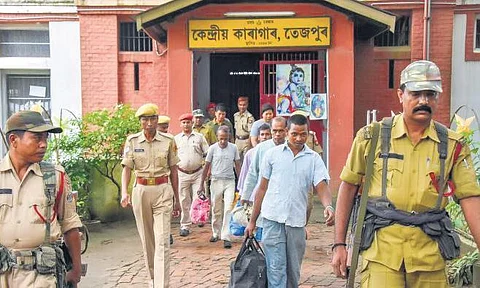

The year of 2019 ended with the country deeply divided on the National Register of Citizens (NRC) and the Citizenship (Amendment) Act (CAA). While the matter is under consideration of the court, it is evident from the protests that a large section of people do not trust the government’s assurances on the same. The protests caught not only the government but even the Opposition parties napping. The Opposition parties rallied fast to create a situation of armed riots in our cities, with many anti-social elements indulging in arson.
In many states, the police acted no better. One reason why the protests turned violent could be the apathy Indians have against the country’s bureaucracy. The idea of grovelling before a bureaucrat to prove that you are an Indian is the stuff that nightmares are made of. This could be the reason why even after the Prime Minister’s assurances, the agitations have refused to die down.
In Assam, the NRC exercise took 10 years. It involved 52,000 government officials to decide how many of Assam’s 3.4 crore people are Indians. There were two heads under which the documents were submitted by the citizens who had to prove they were Indians. It was a mammoth exercise, which ended up in a farce with almost 19 lakh people suddenly finding themselves not Indian citizens anymore. They have the chance to appeal to the Tribunal and if unsatisfied, they can file cases in the court.
Let us assume that the national-level NRC will be done differently, as Assam NRC was court-mandated and had the Assam accord to consider. The Citizenship Act, 1955, states that anyone born in India on or after January 26, 1950, up till July 1, 1987, is an Indian citizen by birth. Anyone born on or after July 1, 1987, and before the commencement of the Citizenship (Amendment) Act of 2003 and either of whose parents is an India citizen at the time of his birth is an Indian citizen. Anyone born after the Act was passed in 2003 and if both his parents were Indian citizens at the time of his birth, is also an Indian citizen. Nationwide NRC will have to follow these criteria.
However simple the procedure is going to be, 130 crore Indians must apply to prove their citizenship. Even if one needs to submit five papers to prove the citizenship, it would be approximately 650 crore papers to sieve through and determine who is an Indian citizen and who is an illegal migrant. Let us assume, the entire India works with the same efficiency as the Assam government. Assam took 10 years to produce a highly contested and flawed report. If we extrapolate it to all-India level, we will need approximately 20 lakh government officials working for 10 years going through six billion documents.
The direct cost is estimated by experts to be around Rs 75,000 crore. The indirect cost in the form of lost manpower of both the government officials and the public running around to prove their citizenship will be unimaginable. As on 2019, 26 per cent of Indians are illiterate, and this is an optimistic number. There are 50 crore landless poor in India. The NRC exercise expects all the citizens to prove through documents that they are Indians to an indifferent and often tyrannical petty bureaucrat.
The only power the poor and the oppressed in India have is their vote. If the exercise disenfranchises them until they can prove they are Indians with documents that they cannot even read, the state takes away that power too. In terms of human suffering for a tall promise and vague results, it would ace demonetisation by a large margin.
In Assam, this army of bureaucrats excluded 19 lakh out of a 3.4-crore population, that is 5.5 per cent, after 10 years of hard work. If the nationwide NRC is like Assam, the proportion of people that could be excluded would be 7.15 crore. All these people can go to the Tribunal to challenge such exclusions. The Tribunal must go through the documents provided by 7.15 crore people, conduct hearings and give its verdict. Let us assume, the Tribunal admits half of the excluded as citizens after many years of hearing.
The other half—approximately 3.5 crore people—can approach the court, requesting to quash the Tribunal’s verdict. They could also challenge the verdict favouring a few and excluding them. The courts would be flooded with such litigations and this can go up to the Supreme Court. Already, Indian courts are burdened with humongous number of cases, some stretching from the British era. By the time, the Supreme Court gives orders on these, most probably the grandsons of these so-called illegal immigrants would have passed behind the curtains of time.
One should ask, for what is this exercise being planned. The Foreigners’ Tribunals’ (FT) estimate of illegal immigrants, who are not Hindu, Jain, Parsi, Christian, Sikhs or Sri Lankan Hindus, is less than a lakh from 1964 to March 2019. Even if the NRC can find out 10 times this number, it would be a million people. What are we going to do with them? Are we going to keep them in detention centres? The Assam detention centre for 3,000 people cost around Rs 46 crore.
The detention centres for 10 lakh people would cost Rs 15,300 crore for just building it. No country is going to take them, as we can’t prove they belong to any country. How many days are we planning to keep them there at taxpayer’s money? Unless this announcement is a part of a political game to divert the attention from the failing economy and growing unemployment, this does not make sense. Not even George Orwell at the peak of his abilities could conjure such a dystopian plot.
mail@asura.co.in